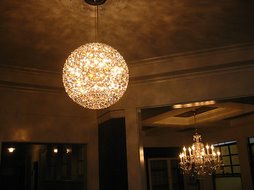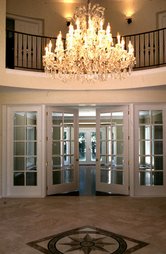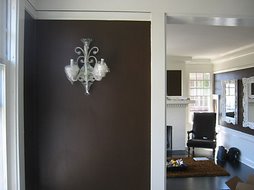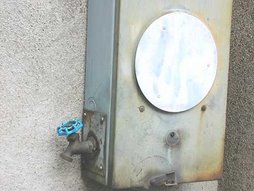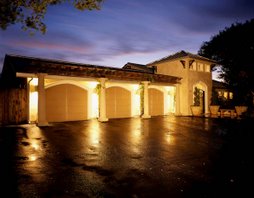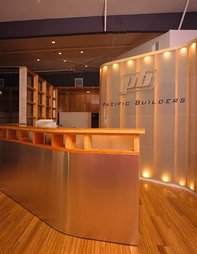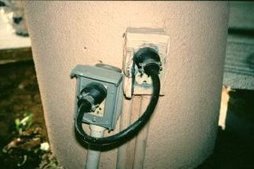Electric generators are potentially lethal if not used properly. There is a very real risk of injuring or killing someone working on power lines with a generator improperly connected to your home. Homeowners should know the correct way to use a backup generator. This page will explain how a generator transfer panel is properly installed. It will alert you to potential dangers and provide some insight on the workings of electricity. You will better understand the reasoning behind the need of a transfer panel instead of a simple double male extension cord. It is not my intent to encourage homeowners to make wiring changes, but rather to provide information which will promote safe and proper generator use. This knowledge can be used while choosing an electrician to do the installation work, and clarify what is being done. You will be able to ask intelligent questions, and maybe even point out wiring errors which must be corrected.
In many areas, any additions or upgrades to an electrical system is required to have an electrical permit authorized by the local electrical authority. You must be a licenced electrican to obtain a permit to do such upgrades, including any generator transfer panel installation. In the event of a fire directly related to an improper installation, you can be charged and your house insurance may not cover the damage.
In defiance of such rules, people often make electrical changes as they see fit, whether to install a dimmer switch, or to wire their newly renovated basement. In this situation, I encourage people to respect electricity, do the work correctly, and not take short cuts that could jeopardize the safety of themselves or others. A transfer panel installation is more involved than the typical do-it-yourself electrical job. Every installation will have its own set of unique conditions. Use information presented as a basic guideline only. I do not recommend this project be attempted by the average home owner, and anyone qualified to do such work will likely not need this page at all. Electricity is a useful tool, but it can kill and burn if not used properly. If you are not fully qualified, knowledgeable, and experienced with the workings of home electrical systems hire someone competent. Click on all links and read thoroughly before proceeding.
Safety first. Never connect a generator by using a double male cord plugged into the dryer or stove outlets. This technique is referred to as backfeeding and is potentially very dangerous. Do a web search for generator backfeed and read the responses. Backfeeding creates a possibility of returning power to the grid with potentially lethal results to people trying to repair the power lines. Even though you may know to turn off the main breaker, what will happen if someone else decides to connect the generator and leaves it on? These techniques are along the lines of playing Russian Roulette, except you are gambling with someone else's life. Do it right or don't do it at all.
The safe (and legal) approach is to install a proper transfer panel to provide isolation. The panel will have two breakers through which power feeds. It provides a mechanical lockout system that prevents both breakers from being on at the same time. One breaker is fed from the main panel and normal power, the other connects to the generator. Alternately, extension cords can be used to plug in a freezer or fridge directly to the generator. The furnace can be rewired to use a twistlock wall outlet and connected the same way. Make sure to use cords which are in good condition and with proper current ratings.
Always ensure the neutral wire in the generator is connected through the 4 conductor extension cord.
I've compiled a list of improper installations and bad advice. Click to view the bad installation examples.
Equally important for homeowners is the danger of carbon monoxide poisoning. Ensure adequate ventilation whenever operating a generator. Never operate a generator indoors, in an attached garage, near open windows or air intake ducts for a ventilation system. Carbon monoxide is odorless and its affects may be not noticed until it is too late. Keep the generator away from flammable objects and direct hot exhaust gas away from the house.
Carbon monoxide is an odorless gas which is present in the exhaust fumes of all internal combustion engines. Read more about Carbon monoxide poisoning.
Quoting from the web site...
You can't see or smell carbon monoxide, but at high levels it can kill a person in minutes. Know the symptoms of carbon monoxide poisoning. At moderate levels, you or your family can get severe headaches, become dizzy, mentally confused, nauseated, or faint. You can even die if these levels persist for a long time. Low levels can cause shortness of breath, mild nausea, and mild headaches, and may have longer term effects on your health. Since many of these symptoms are similar to those of the flu, food poisoning, or other illnesses, you may not think that carbon monoxide poisoning could be the cause.
Always supply adequate ventilation when operating a generator. Never operate a generator indoors, near an open window or intake ducts for a air exchanger system. The carbon monoxide fumes could enter the home from outdoors. Your home should have a carbon monoxide detector. A fireplace or furnace can malfunction and fill a home with carbon monoxide as well.
Here is a pamphlet published by First Alert. Questions & Answers about Carbon Monoxide Poisoning, page 1 and page 2.
